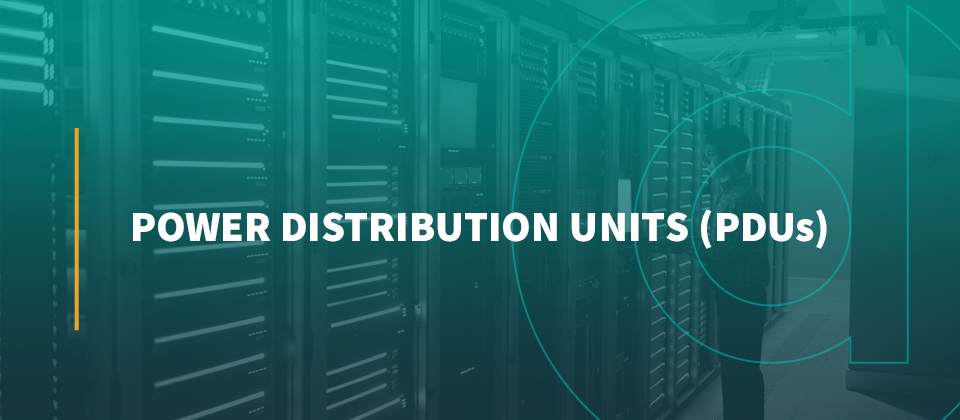Power Distribution Units (PDUs)
Power distribution units (PDU) refer to the electrical components required to manage the electrical supply that runs servers, computers and networking devices for data centers. Though PDUs started as power strips with limited capabilities, modern PDUs can handle large businesses and come with features such as remote monitoring and access. With a powerful rack- or floor-mounted PDU, your business can improve efficiency, reduce maintenance costs and protect your equipment from surges.
What Are PDUs?
PDUs are devices that control a data center’s electrical power. In its most basic form, a PDU can be a power strip without a surge protector, though these types of PDUs don’t offer much protection or efficiency for your data center. All modern data centers instead rely on rack- or floor-mounted PDUs that provide data on power usage effectiveness.
Every PDU turns one or more power inputs into more power outputs, which typically amounts to eight power units. While they can’t generate power themselves, a PDU can deliver AC and DC power from an uninterruptible power supply (UPS) and prevent your equipment from damage during electrical surges. High-power PDUs for data centers are so efficient that they allow managers to consolidate equipment and lower the costs associated with receptacles and plugs.
Common Types of PDUs
Simple PDUs are useful for households and small businesses, but data centers must invest in high-power PDUs. These PDUs can handle enough power for large companies and can be combined to create larger PDU systems by joining the racks together. The smarter the PDU, the better the investment and the greater your chances of saving money on energy efficiency, productivity and maintenance.
Rack-mounted PDUs, or intelligent or smart PDUs, work directly with an equipment rack and monitor the flow of power to switches, servers and the rest of your data center’s devices. They are essential for balancing large power loads and protecting against electrical surges and are typically 19-23 inches in width. Each rack-mounted PDU includes a three-phase display for device sharing power alongside Simple Network Management Protocol (SNMP) remote management tools.
Floor-mounted PDUs — or main distribution units — act as a bridge between your office’s primary power and the equipment racks in your network operations center and data centers. Compared to ordinary power strips, PDUs handle more energy and can provide energy to multiple equipment racks.
How to Choose a PDU
Depending on the size of your data center, it’s not easy to determine which size PDU you should pick. As computer demands more power and your business continues to grow, you’ll need a PDU that can keep up with your demands. There are several factors to take into consideration when determining the right PDU for your data center’s future endeavors:
1. Plug Type and Quantity
Determining the correct PDU for your environment begins with identifying the output plug type you need and choosing the right IT equipment for your rack to operate. Your PDU should have more C-13 and C-10 outlets than you initially need to allow for future equipment expansion.
2. Power Capacity
After you’ve determined the equipment you’re going to power with your PDU, you must estimate the power capacity required per IT rack. Many PDU manufacturers offer online calculators that allow you to accurately estimate the power draw necessary for specific electronic configurations.
3. Plug Type and Power Distribution
During the third step, you must make a precise calculation for your PDU’s row power distribution based on its site voltage. Determine whether a rack requires single- or three-phase power and figure out the distribution scheme.
4. Visibility and Control Options
Now, consider the visibility level of your rack-level power status. There are three levels of power visibility — basic, metering and monitoring. This step requires monitoring instantaneous and overall power consumption over an extended period of time using metered racks or upstream metering.
5. Form, Factor and Mounting
In the final step, you must select your PDU’s form factor and mounting options and provide a redundant power supply that kicks in if the main system fails. Then, install the PDUs into the back of your server cabinet with the outlets easily accessible.
What Are the Benefits of PDUs?
PDUs do more than managing electrical power to your servers and networking equipment — they deliver long-lasting advantages and increased efficiency to data centers worldwide. With a PDU, you can increase your IT installation’s reliability, efficiency, cost-effectiveness and more.
Reliability
The main benefit of PDU systems is their ability to increase your IT installation’s reliability with a redundant power supply. This feature protects your tech in case of both power outages and electrical surges and reduces costs associated with downtime by letting your staff keep working no matter what happens. Some newer PDUs even have a plug retention feature that improves reliability while taking up no additional space.
With the right PDU, you can improve your tech infrastructure’s reliability and prevent downtime.
Energy Monitoring and Control
PDUs also provide you with superior energy monitoring with a 1% billing grade accuracy. This information lets you quickly identify rogue hardware and spare power capacity. With a newer PDU, you can take control of your power and turn individual sockets on and off remotely. Whether you need to remotely restart a server or disconnect non-essential loads during a power failure, smart PDUs have you covered.
Simplify Administration and Save Money
Newer PDUs save you money on data center maintenance and allow you to hot-swap server components to install hardware upgrades with ease. Color-coded PDUs allow your maintenance technicians to easily understand the circuit breaker and power supply connections of your PDUs and perform maintenance faster than ever. With a newer simplified rack, you can simplify administration and reduce physical infrastructure costs by running multiple PDUs through the same IP address and port.
Learn More About DataSpan’s Power Solution Services
Finding the right PDU is easy with the knowledge and experience of DataSpan. DataSpan has been providing businesses worldwide with technology solutions for 50 years and is uniquely equipped to handle your business’s data center challenges.
DataSpan has the experience necessary to give your data center peace of mind. Reach out to a DataSpan representative to learn how we can rise to the demands of your business and support your data center in every aspect of its operation.
Linked Sources:
https://dataspan.com/blog/data-center-power-redundancy-and-its-importance/
https://dataspan.com/blog/how-to-manage-power-efficiently-in-data-centers/
https://dataspan.com/blog/the-costs-of-unplanned-data-center-downtime/
https://dataspan.com/contact-us/

About the Author: Alex von Hassler’s long term focus is the continued testing, learning, and deployment of modern IT solutions. During his years as a DataSpan team member, his responsibilities grew from managing Salesforce CRM to improving system security, creating marketing initiatives, as well as providing continued support to the highly motivated and experienced team in an ever-changing industry. As DataSpan evolves to provide the best-fitting IT solutions to its customers, Alex von Hassler continues to hone his skills in the world of web-based ERP systems, security, and best customer engagement practices. Empowering such a dynamic team with the right tools provides him with enormous gratification.








